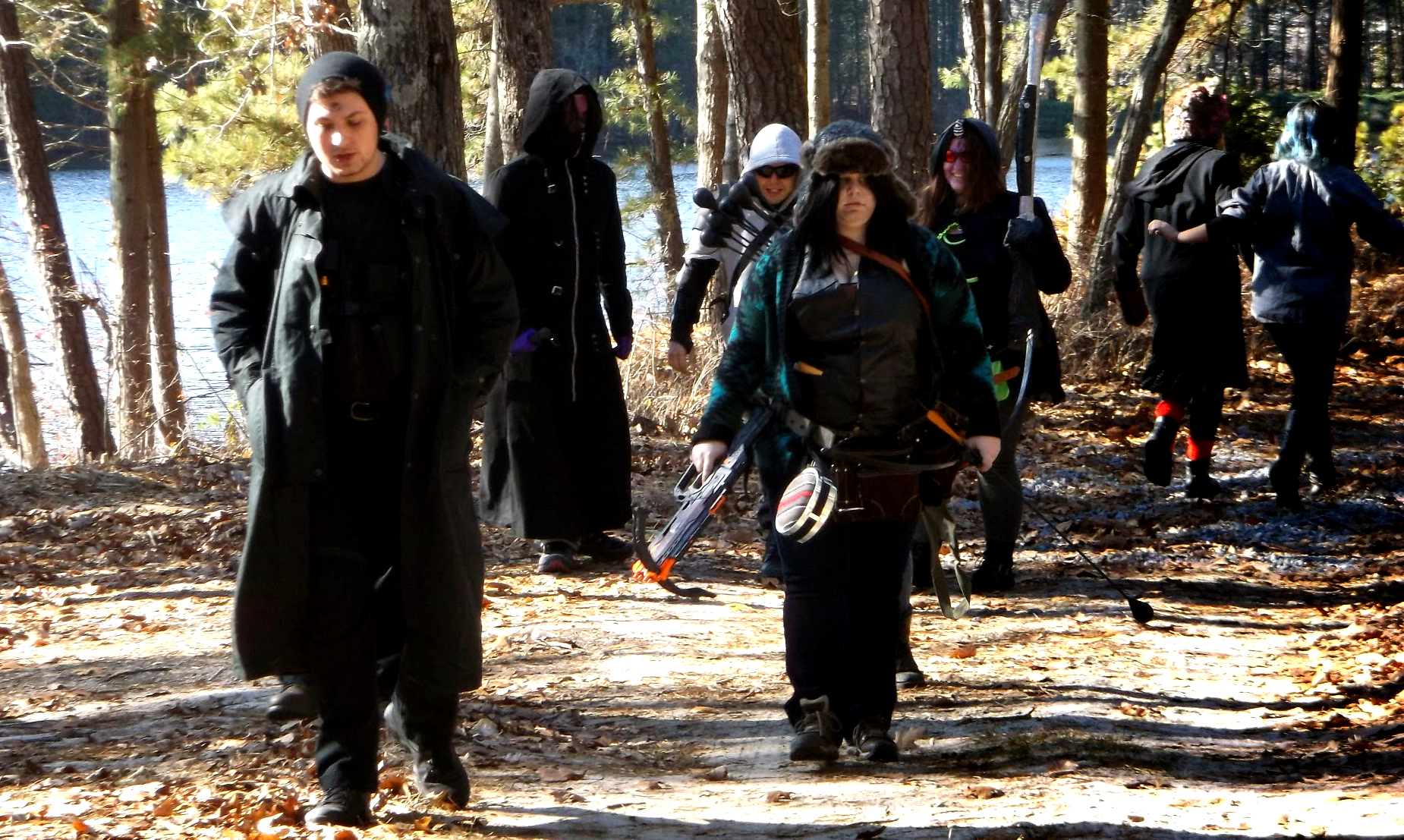All right, gamers. By now, a lot of us know what larp is. It’s kind of like the child of impromptu theater and make-believe with friends, but with some rules and setting guidelines. As described in 14 Myths (and Truths) About Larping, it’s a social activity. The genre is defined by person-to-person interactions. But, that’s old news. These days, almost everyone and their dungeon master has had a run-around in the woods with a goblin mask and boffer weapons—or experienced an in-character dinner and drama. There’s new stuff on the horizon, folks. A new ‘final frontier’ in larping, as it were: digital larping.
What Is Digital Larping?
Called ‘remote larp’ or ‘digital larp,’ and it’s starting to make its way around the community. For a long time, larps have been sorted on the sliding scale of role-play to boffer ratio. But, get this. No one even has to be in the same location with this new-style techno-larp. The entire game or experience takes place over the internet, via a service like Google Hangouts, Discord, or Skype. Each player has a character and interacts with other players, still in character, over the net.

The Geek Initiative Founder Tara M. Clapper prepared for a remote larping role for The Game Theatre. Image: instagram.com/faeriebrowncoat
We’ve seen baby-steps in this direction before. In some Cyberpunk larps, characters and players keep in touch by keeping in-character twitter accounts as groups break off across large areas. It was the only way some people could keep their team wrangled during Gen Con’s large Shadowrun larp events. There were moments where the hair stood up on the back of my neck as the team waited for an NPC account to reply to us via Twitter. So while some people on the hater-ade might dismiss technology in larps as immersion-breaking, it’s not. Technology is a tool, and what matters most is how it’s used. If it’s done right, tech can enhance the entire experience.
Since I had never been in a fully digital or remote larp, I reached out to Tara Clapper of our own The Geek Initiative. I knew she had a few larp irons in the fire via social media, and asked if I could silently sit in one one of her games. Luckily, she gave me permission and I put down a reminder to free up some time before 8 p.m. on the first game’s date.
The game started on Google Hangouts, and I was one of the first people to arrive. Tara had built in a little extra time, just in case some people had technical difficulties. It turned out that I wasn’t the only silent observer! The other ‘ghost’ and I turned our accounts to mute our audio and turned off our cameras as things started rolling.
What Happened in the Digital Larp
First, all the players introduced themselves for a few minutes, mostly going over the topic of how long they’d been larping, etc. There were a little over half a dozen players in this game, and it took a little time for everyone to log on. Tara then went over the safety rules and game mechanics, making sure everyone understood. Then, there was a short break to costume-up and get into character.
The final player arrived a little late, and Tara made sure to give him a version of the rules once he arrived. She asked if anyone had any questions about the rules and safety protocol, and then called game-on. Most of the rules focused on emotional safety and communication.
In this case, the story was built around the players all discovering a private video chat server. Everyone tried to make sense of what was going on, and their particular place in it. Twice, guest characters signed on and spoke with the players. What was really interesting in digital larping is that the players actually all had to make sure only one person was speaking at a time. There wasn’t an opportunity for people to split off into small knots and miss critical in-character information due to side conversations.
Why Digital Larping?
Digital larp has a few unique appeals over traditional larp. First, it’s super accessible. Very few nature trails are wheelchair friendly, but remote larp allows players who could not otherwise participate do so. It also cuts down on that problem many face, that players are moving away from each other. So this might be a good solution to get the gang together for a game, regardless of how many miles each person is away from each other. From a business perspective, digital larping also allows for a larger player base. There is no worry about how far away your players are; they can still participate if they have the desire to do so.
There is also little to no upfront investment on a player’s part. Most people these days have smartphones or a computer with a built-in camera and microphone. Also, there is no site fee to worry about. And, relevant to sites, there’s no danger of a group of muggles wandering into your site and disrupting your game. One of us at TGI had a rather frightening experience wherein some hunters, without permission of the landowner, had broken onto the site we had booked for larp that weekend. Those same hunters tried to intimidate our group into leaving—until they found out we were there with the permission of the landowners. Needless to say, that’s an experience that won’t repeat on digital larps.
It’s a viable business model. In general, the people who pay for blockbuster larps may not be the same clientele as frequent remote larpers (though some certainly are). But, Tara Clapper has proved that people are interested, and they are willing to pay for tickets to attend. If the idea of moving an entire larp to a remote model isn’t pleasing, there is always the opportunity for a few players to remote-in—or for remote larp to be a viable option during the winter. Just a few games out of the season could be digital, and Tara’s ready to support that—at no up-front investment to the games hoping to make accessible content for their players (and maybe a bit of operational profit, as well).
Digital larps can also be great ways to raise hype for site events, or as a way to stream an on-site event to raise awareness of an existing larp. Given the popularity of streamed tabletop games like Critical Role or Dice, Camera, Action, it isn’t out of the realm of possibility that some people might one day be digital larping celebrities.
Add a Remote Component
As a game-runner, you may also want to test out the remote-component with an NPC (non-player character). Or, maybe you’d like to test out a single module with a remote puzzle component. The Geek Initiative’s very own Tara Clapper is more than happy to professionally consult on your projects. If it meets your needs, she can also bring in a larger team.
Who is Remote Larp Good For?
Generally, this is good for most gaming groups. One complaint a lot of larp players make is that larping becomes harder in extreme weather, or around high-traffic holiday times. A few digital sessions might take the edge off those larp cravings for your group. It also allows for some creative additions to larp in general, and TGI’s team always comes in costume.

Tara explained that digital larpers have gotten pretty creative with their costuming. One even played a hacker with transposed images over his face during a sci-fi larp.
An in-character remote larp-in to dinner with some NPCs or other players might make for a fun crowdfunding reward. Or, maybe you’re just looking for a mysterious character to show up via computer screen or crystal ball to drop cryptic hints to your players. Or, maybe you’re looking to run a game at a convention? If you connect your players via smartphone, it could make for some heart-pounding moments as the parties are split—but they can each get a pretty good idea of something exciting is happening with the other group. Or, perhaps only one or two players can meet an NPC at a time, or solve a puzzle? Really, separation breeds excitement and anxiety—both of which a game runner can use to create tension. The possibilities are endless and game designers are already employing these tactics.
Even non-game runners could enjoy this. If you have a popular intellectual property, but you don’t want to take the time to run a game yourself, TGI may be an answer. You could gain some money from ticket sales while a team handles this, and you’re free to keep your busy schedule.
Wouldn’t it be nice to have a small group of modules over the winter, where everyone in your group can keep cozy in their own homes? It also allows for chronically ill gamers to get in on the fun with their more able-bodied peers. Nothing sucks more than having to miss out on game because of a flare-up. So your game might find use out of a digital way to get your players to the game—even if their bodies aren’t exactly cooperating.
The only real limitation on remote larp (or digital larping) is imagination. And if you’re short on ideas, Tara’s digital larping team can help you out with some of those, too. If you’d like to check out this new digital and remote larp thing, contact us at The Geek Initiative. Do you have some interesting ideas not mentioned here? We’d love to hear those, too.
You can email Tara directly: tgicontentservices@gmail.com—or reach out to her via The Geek Initiative Larps on Facebook. What to participate? Everyone’s welcome to join our TGI Larps group.






